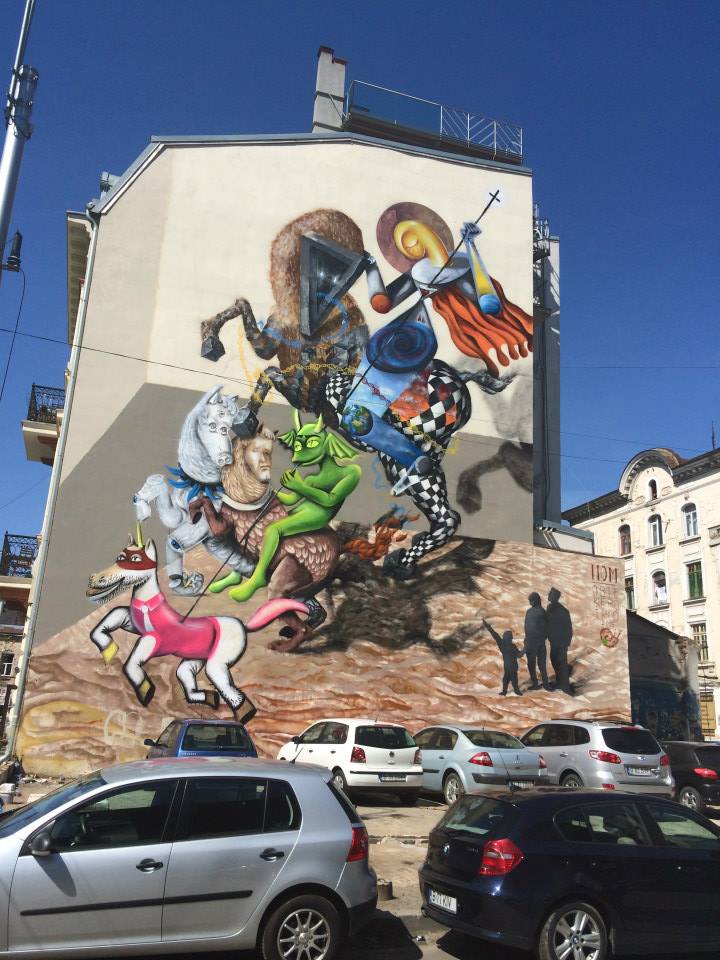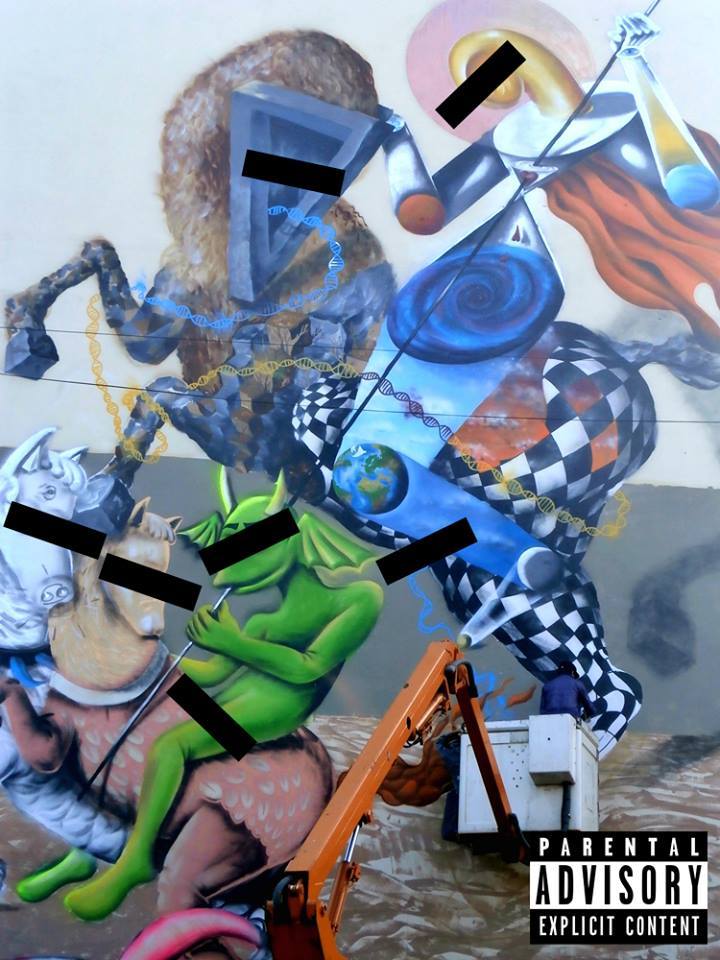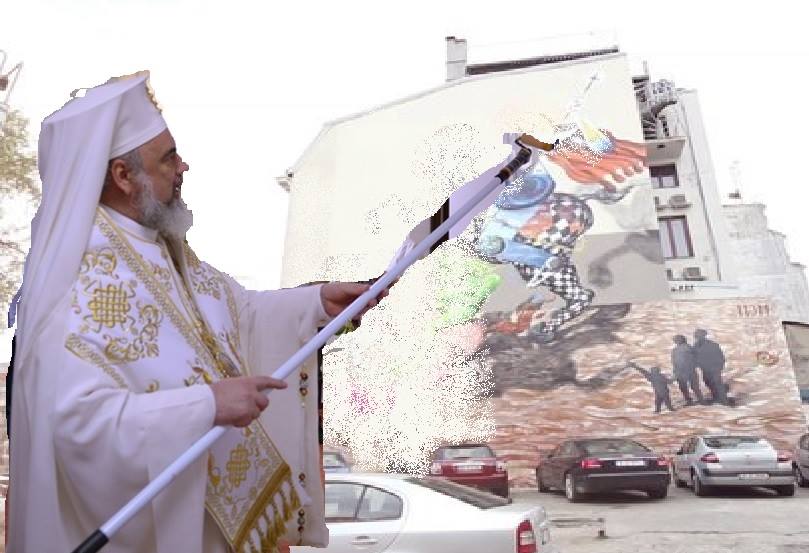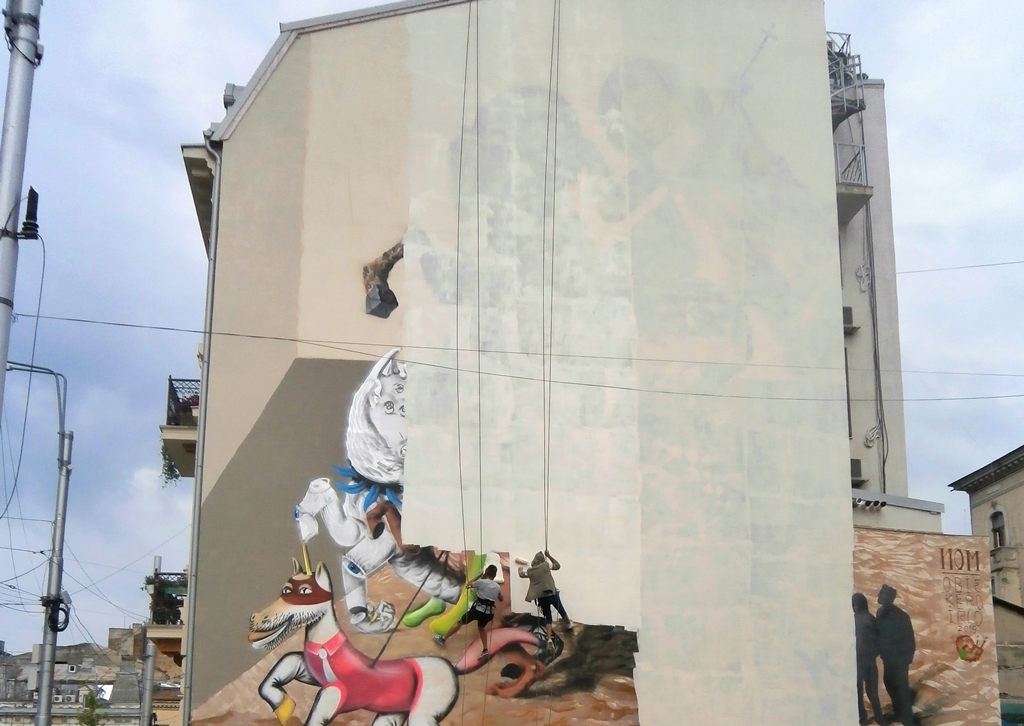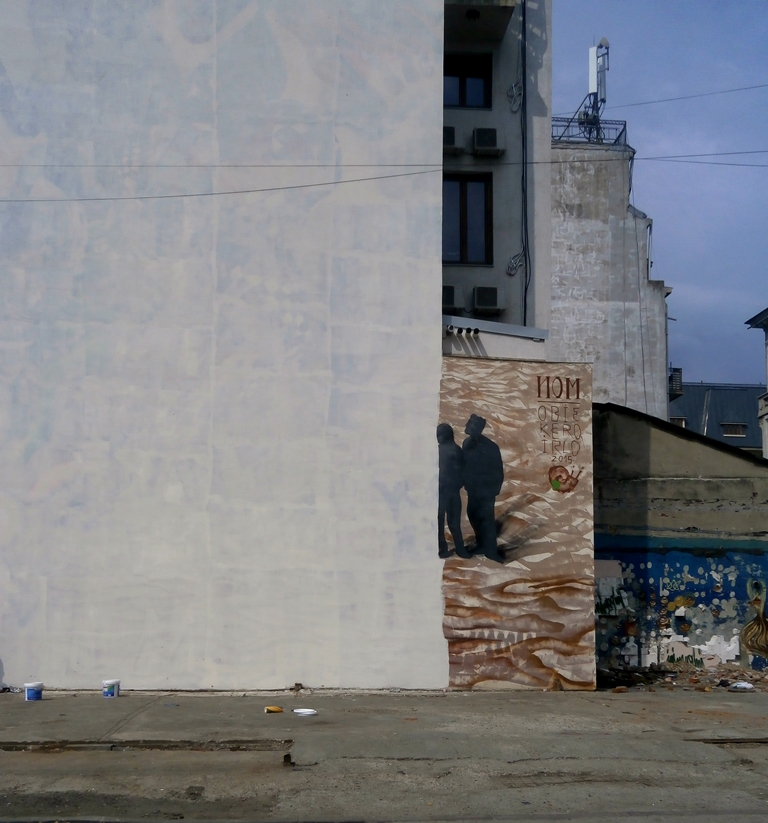UPDATE: Mural by NOM Crew, now a white wall
We recently wrote about what we considered to be a case of religious censorship of a mural painted in April by NOM Crew, inspired by Saint George and the Dragon. Things have evolved rapidly in the past week, with the national and local press, as well as project sponsor and curator, church representatives and ordinary people sharing different thoughts regarding the piece and discussing whether it should remain, be modified or simply turned back into a white wall. The result was that today, May 9th, in the morning, it was painted over. Here is the evolution of events to date, as we tried to document the entire story (most of the sources we link to are Romanian only).
Finished wall/ Photo: Interesting Times Bureau
Mural painted over on May 9th / Photo: The re:art
Point of view #1: Press & Blogs
The press mainly focused on the pressures to erase/ change/ replace the wall, seemingly made by the Parochial Council of the Church Sfântul Gheorghe – Nou, situated near the place where the wall was painted. Many, and we had a similar position, were disturbed and offended by the idea that the orthodox church representatives could decide over the faith of the mural, thus linking their involvement to censorship.
ProTv showed different opinions regarding the wall, which some consider to be masonic and devilish and others perceive to be a work of art, and as the curator of the project declared on several occasions, with no intention to upset those living in the area nor the church.
Europa FM announced on May 7th that the wall will be erased on Monday, May 11th, and had interviews with the priest of the church, Emil Cărămizaru, who expressed his opinion that the work is a caricature of the saint and considered it can be offensive for Christians who might believe it is actually a representation of the saint and due to its visual impact in a public space. But he also said that the artist has the right to express himself in the limits of an exhibition space, at home or elsewhere, and not in a protected area and only if the urbanism laws allow this. Artist Dan Perjovschi was also interviewed on the matter and made two drawings in regard to the mural. He explained that the artist is responsible for what he or she creates in the public space, and at the same time expressed his opinion about censorship and freedom of expression.
Images: Dan Perjovschi
Vlad Petreanu pointed out that this is not a matter of whether you like the piece or not, find it beautiful or ugly, intelligent or stupid, but that someone who does not like it (and may misinterpret it, as we already discussed in our initial post) has the liberty to erase it due to status. He was one of the first to raise attention to the fact that although church representatives talk about laws and urbanism, they seem undisturbed by the state of misery of this “protected” area, which is full of syringes, garbage and swearwords written on walls, as we saw today, when the mural was erased. Meanwhile, Gândul interviewed the sponsor of the project, who announced that there was an understanding between all parts to create a new mural, with no religious theme, so that the area could benefit of an artistic intervention, an amiable and not an official agreement, as later confirmed by Mediafax.
The satire website Times New Roman presented their vision of how the mural should look according to the church, using the image of Patriarch Daniel, most probably to criticize the wealth of church nowadays and the discrepancies between what the religion stands for and how some choose to practice it as members of the church.
Images: Times New Roman
Point of view #2: Beauty is in the eyes of the beholder. Opposite reactions
A normal two sides of a story quickly began after the press started spreading the news. On one hand, you had people who vehemently protested against the mural, talked about what should be accepted and not in the public space, to what extent freedom of speech is actually free, or simply found it inappropriate for their taste or beliefs, even accusing the artists of satanic representations. On the other hand, people showing support for the project went from simply expressing their discontent with the decision of the mural being erased to comparing the situation to #JeSuisCharlie or adopting an anti-BOR position (and it is important to highlight that many were against the church as an institution and not to religion overall, there were some who compared the church with ISIS), others reminded that it is not the first time when an artist reinterprets the Saint George episode or that the church is permissive when it comes to its interests, painting politicians on the walls of churches. Some even created a Facebook event to gather people for a protest in support of freedom of artistic expression, where many had different views, more or less aggressive, about the situation. Dan Perjovschi created a Facebook album with the reactions of people to the painting over.
Image: Wanda Hutira
Image: Balamuc
Image: S8AN
While most are caught in the debate, others saw opportunities in the story. The mural became a cover for a book and was used as a t-shirt design. Trendy, right? Read more about the commercial use of street art and graffiti in a previous article.
Point of view #3: The Parochial Council of the Church Sfântul Gheorghe – Nou, on the safe side
The Parochial Council launched an official statement that they do not have the quality to censor the mural, that the authorities are the ones who should react considering the fact that it is a protected historical area (which actually looks like a favela, so we agree that authorities in measure to protect it should do so and hope that people will take notice of the real problems in the area), that the discussion regarding the mural was between the owner of the building and the people living in the area, and there was no intent of censorship, but only of expressing an opinion.
The same Emil Cărămizaru, the only voice to speak on behalf of the church by now (according to our research) and the one we mentioned above, insists in an interview that art should manifest only in dedicated art spaces (so artists should “behave” when it comes to expressing themselves outside the gallery?), asking rhetorically how would it be if all of us would paint walls anywhere and anyhow, also adding that he believes the press and artists want to benefit from the subject’s booming visibility. So no real problem here, only false censorship accusations, as we can conclude.
Point of view #4: The response of people directly involved in the project
While the sponsor explains to Gândul that there was no conflict intended, but on the contrary, that they wanted to contribute to the urban development of the area through an artistic intervention, VICE found out that the project had no official authorization to paint the mural and that procedures for such a project were not known by all involved. Artists explained that they created the concept of the mural on the spot as they usually do, and have not submitted any sketch for approval. Indeed, if it was painted two blocks away from the church, would it have been a problem? Perhaps not. There were no bad intentions, say the artists, no satanic goal and no denigration of religion: “We are also part of it”.
Point of view #5: The City Hall brings back the white wall
Perhaps facing pressures from all sides in the end, The City Hall found what they believe to be a solution. Two workers were sent on Saturday morning, May 9th, to paint over the mural and avoid the announced protest on Monday and a potential press presence on May 11th, when it was officially programmed to be be erased/ replaced. We managed to take a few photos during the painting over. Confused passerby, a few journalists, an artist (Vasile Mureşan – Murivale) complaining about the status of the contemporary artist today, a few kids on the block lighting their cigarettes and the workers full of white paint, that was it. We did not find an official statement from the local authorities yet, do not know how this will affect future projects here and if a new mural will be painted in the area.
Photos: The re:art
In the end, we believe that the mural attracts attention to its message, that most seem to forget, that no conflict is constructive, as one of the artists told us before all of the above happened. Engaging in a chase for the guilty ones may not be a solution, as both sides are responsible for what happened, nor ridiculing or accusing one of the parts, in an endless hero-antihero/ love-hate approach. Indeed, the church seems to have a negative image both in the press and in the minds of young people especially, but we believe that they have contributed to this perception gradually, justified through various past actions, which are not for us to judge here. And regarding street art, we are still at the level of art vs. vandalism, do not fully understand these types of artistic interventions and have no solid background when it comes to art in the public space. However, the situation, which is not a case of winners and losers, brings a set of important questions to think about, social issues to be aware of, which will hopefully have a constructive outcome in the future.

